Comprehensive Tax Analysis Report: Freedom Insurance Group Limited
VerifiedAdded on 2020/05/28
|12
|1841
|334
Report
AI Summary
This report presents a comprehensive tax analysis of Freedom Insurance Group Limited, examining its financial statements and tax-related aspects. It begins with an overview of the company's equity capital, including contributed equity, reserves, and retained earnings. The analysis then delves into the company's income tax expenses, comparing the 2016 and 2017 figures and explaining factors contributing to tax variations. A key focus is the discrepancy between tax expenses shown in the income statement and tax calculated using the tax rate, highlighting the impact of accounting versus tax regulations, depreciation, and deductible expenses. The report further examines deferred tax liabilities and assets, explaining their recognition and implications, and compares current tax assets with income tax payable. It clarifies the differences between income tax expenses and payable taxes, and between income tax expenses in the income statement and income tax paid in the cash flow statement. The report concludes with a discussion of interesting, surprising, and confusing aspects of the company's tax reporting and offers insights gained from the analysis, particularly regarding tax-deductible expenses and their impact on tax payments.
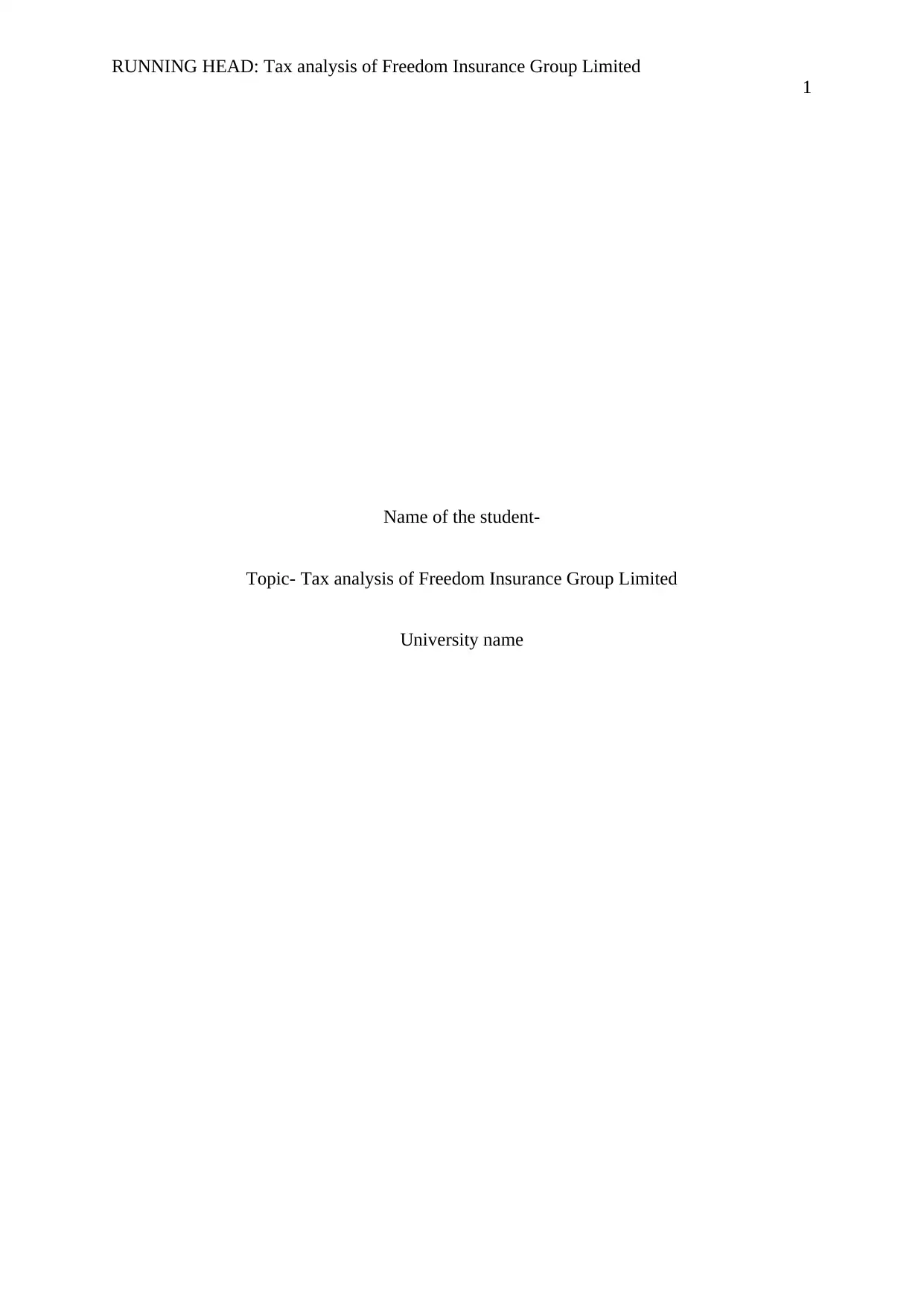
RUNNING HEAD: Tax analysis of Freedom Insurance Group Limited
1
Name of the student-
Topic- Tax analysis of Freedom Insurance Group Limited
University name
1
Name of the student-
Topic- Tax analysis of Freedom Insurance Group Limited
University name
Paraphrase This Document
Need a fresh take? Get an instant paraphrase of this document with our AI Paraphraser
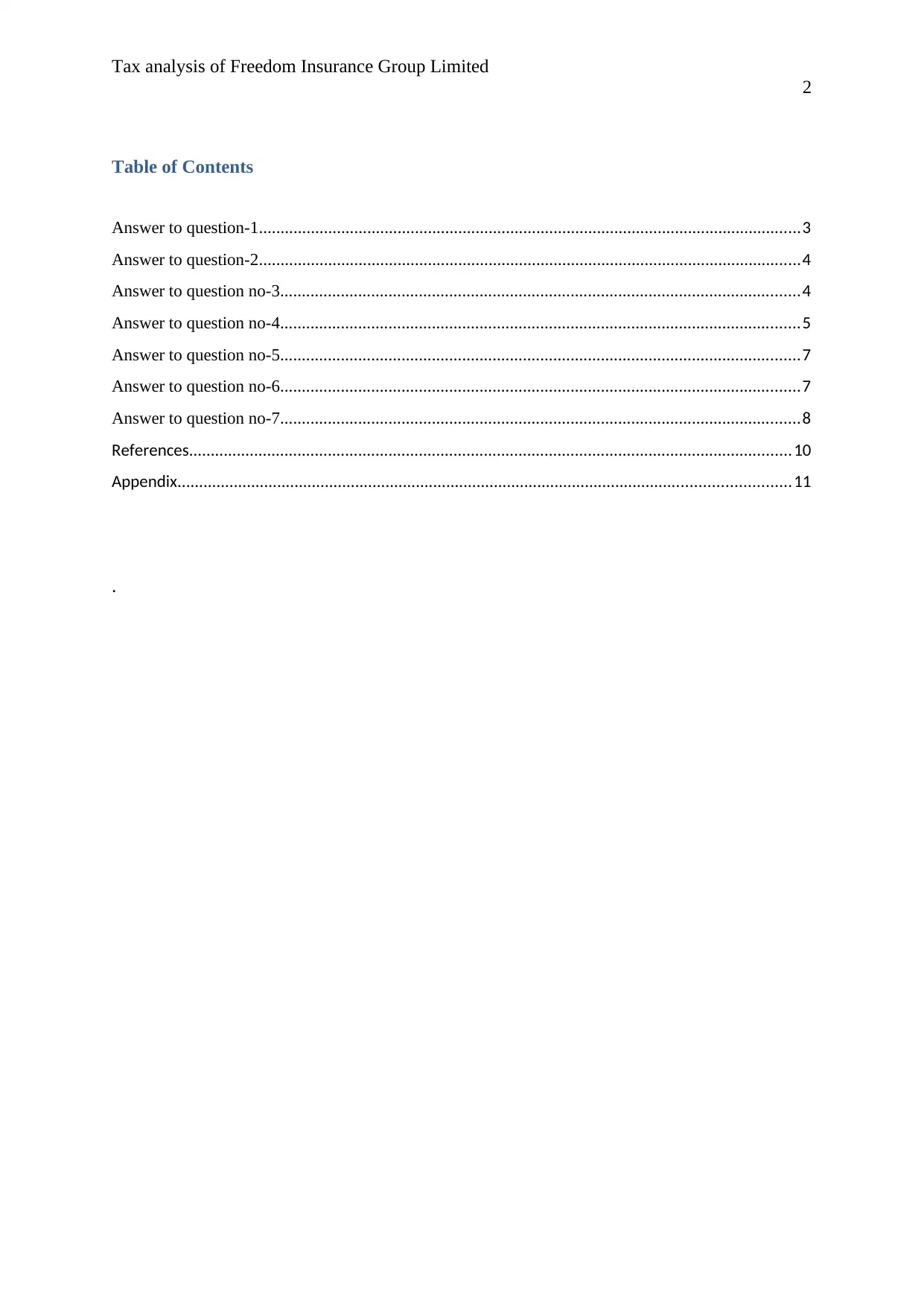
Tax analysis of Freedom Insurance Group Limited
2
Table of Contents
Answer to question-1.............................................................................................................................3
Answer to question-2.............................................................................................................................4
Answer to question no-3........................................................................................................................4
Answer to question no-4........................................................................................................................5
Answer to question no-5........................................................................................................................7
Answer to question no-6........................................................................................................................7
Answer to question no-7........................................................................................................................8
References...........................................................................................................................................10
Appendix.............................................................................................................................................11
.
2
Table of Contents
Answer to question-1.............................................................................................................................3
Answer to question-2.............................................................................................................................4
Answer to question no-3........................................................................................................................4
Answer to question no-4........................................................................................................................5
Answer to question no-5........................................................................................................................7
Answer to question no-6........................................................................................................................7
Answer to question no-7........................................................................................................................8
References...........................................................................................................................................10
Appendix.............................................................................................................................................11
.
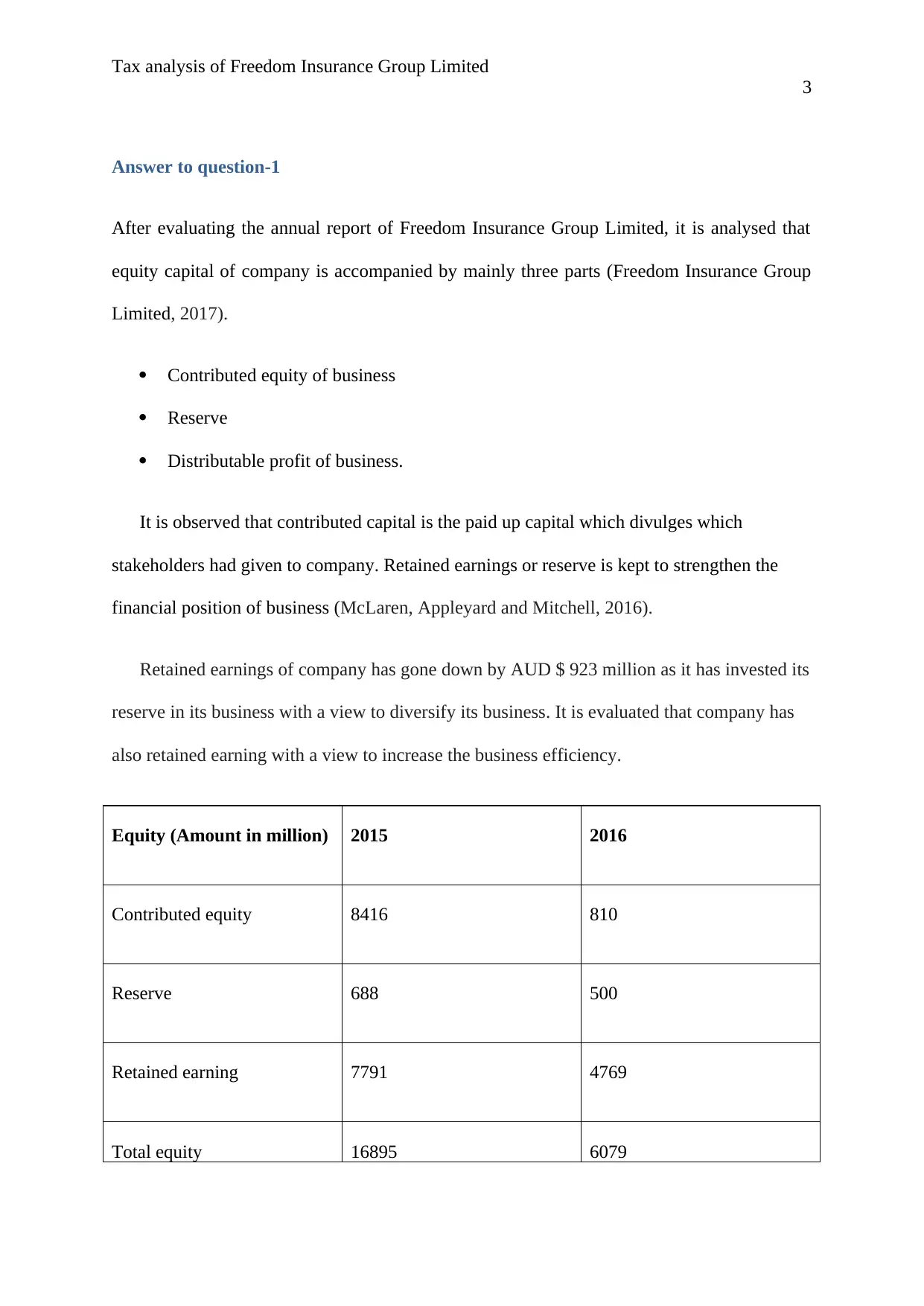
Tax analysis of Freedom Insurance Group Limited
3
Answer to question-1
After evaluating the annual report of Freedom Insurance Group Limited, it is analysed that
equity capital of company is accompanied by mainly three parts (Freedom Insurance Group
Limited, 2017).
Contributed equity of business
Reserve
Distributable profit of business.
It is observed that contributed capital is the paid up capital which divulges which
stakeholders had given to company. Retained earnings or reserve is kept to strengthen the
financial position of business (McLaren, Appleyard and Mitchell, 2016).
Retained earnings of company has gone down by AUD $ 923 million as it has invested its
reserve in its business with a view to diversify its business. It is evaluated that company has
also retained earning with a view to increase the business efficiency.
Equity (Amount in million) 2015 2016
Contributed equity 8416 810
Reserve 688 500
Retained earning 7791 4769
Total equity 16895 6079
3
Answer to question-1
After evaluating the annual report of Freedom Insurance Group Limited, it is analysed that
equity capital of company is accompanied by mainly three parts (Freedom Insurance Group
Limited, 2017).
Contributed equity of business
Reserve
Distributable profit of business.
It is observed that contributed capital is the paid up capital which divulges which
stakeholders had given to company. Retained earnings or reserve is kept to strengthen the
financial position of business (McLaren, Appleyard and Mitchell, 2016).
Retained earnings of company has gone down by AUD $ 923 million as it has invested its
reserve in its business with a view to diversify its business. It is evaluated that company has
also retained earning with a view to increase the business efficiency.
Equity (Amount in million) 2015 2016
Contributed equity 8416 810
Reserve 688 500
Retained earning 7791 4769
Total equity 16895 6079
⊘ This is a preview!⊘
Do you want full access?
Subscribe today to unlock all pages.

Trusted by 1+ million students worldwide
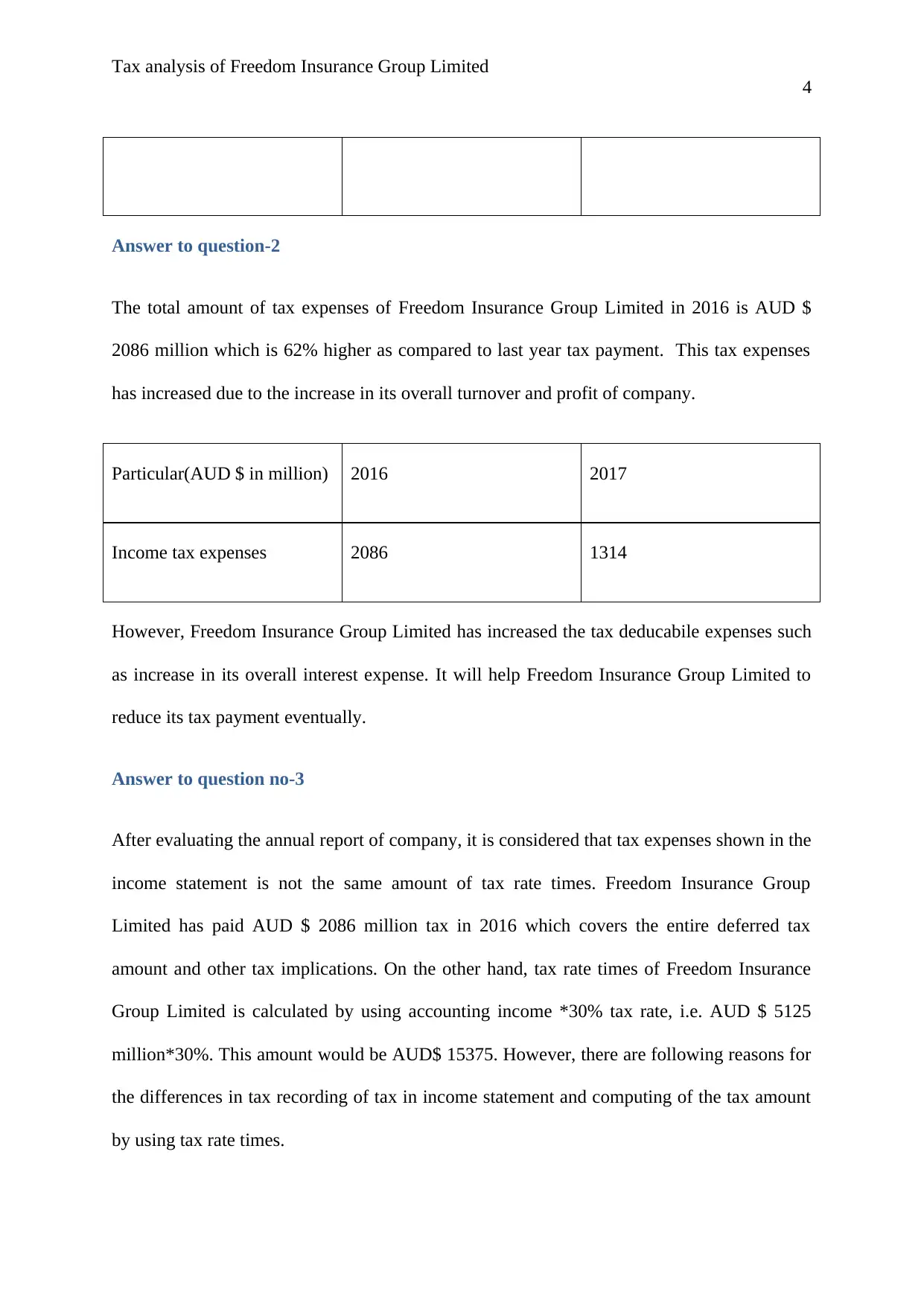
Tax analysis of Freedom Insurance Group Limited
4
Answer to question-2
The total amount of tax expenses of Freedom Insurance Group Limited in 2016 is AUD $
2086 million which is 62% higher as compared to last year tax payment. This tax expenses
has increased due to the increase in its overall turnover and profit of company.
Particular(AUD $ in million) 2016 2017
Income tax expenses 2086 1314
However, Freedom Insurance Group Limited has increased the tax deducabile expenses such
as increase in its overall interest expense. It will help Freedom Insurance Group Limited to
reduce its tax payment eventually.
Answer to question no-3
After evaluating the annual report of company, it is considered that tax expenses shown in the
income statement is not the same amount of tax rate times. Freedom Insurance Group
Limited has paid AUD $ 2086 million tax in 2016 which covers the entire deferred tax
amount and other tax implications. On the other hand, tax rate times of Freedom Insurance
Group Limited is calculated by using accounting income *30% tax rate, i.e. AUD $ 5125
million*30%. This amount would be AUD$ 15375. However, there are following reasons for
the differences in tax recording of tax in income statement and computing of the tax amount
by using tax rate times.
4
Answer to question-2
The total amount of tax expenses of Freedom Insurance Group Limited in 2016 is AUD $
2086 million which is 62% higher as compared to last year tax payment. This tax expenses
has increased due to the increase in its overall turnover and profit of company.
Particular(AUD $ in million) 2016 2017
Income tax expenses 2086 1314
However, Freedom Insurance Group Limited has increased the tax deducabile expenses such
as increase in its overall interest expense. It will help Freedom Insurance Group Limited to
reduce its tax payment eventually.
Answer to question no-3
After evaluating the annual report of company, it is considered that tax expenses shown in the
income statement is not the same amount of tax rate times. Freedom Insurance Group
Limited has paid AUD $ 2086 million tax in 2016 which covers the entire deferred tax
amount and other tax implications. On the other hand, tax rate times of Freedom Insurance
Group Limited is calculated by using accounting income *30% tax rate, i.e. AUD $ 5125
million*30%. This amount would be AUD$ 15375. However, there are following reasons for
the differences in tax recording of tax in income statement and computing of the tax amount
by using tax rate times.
Paraphrase This Document
Need a fresh take? Get an instant paraphrase of this document with our AI Paraphraser
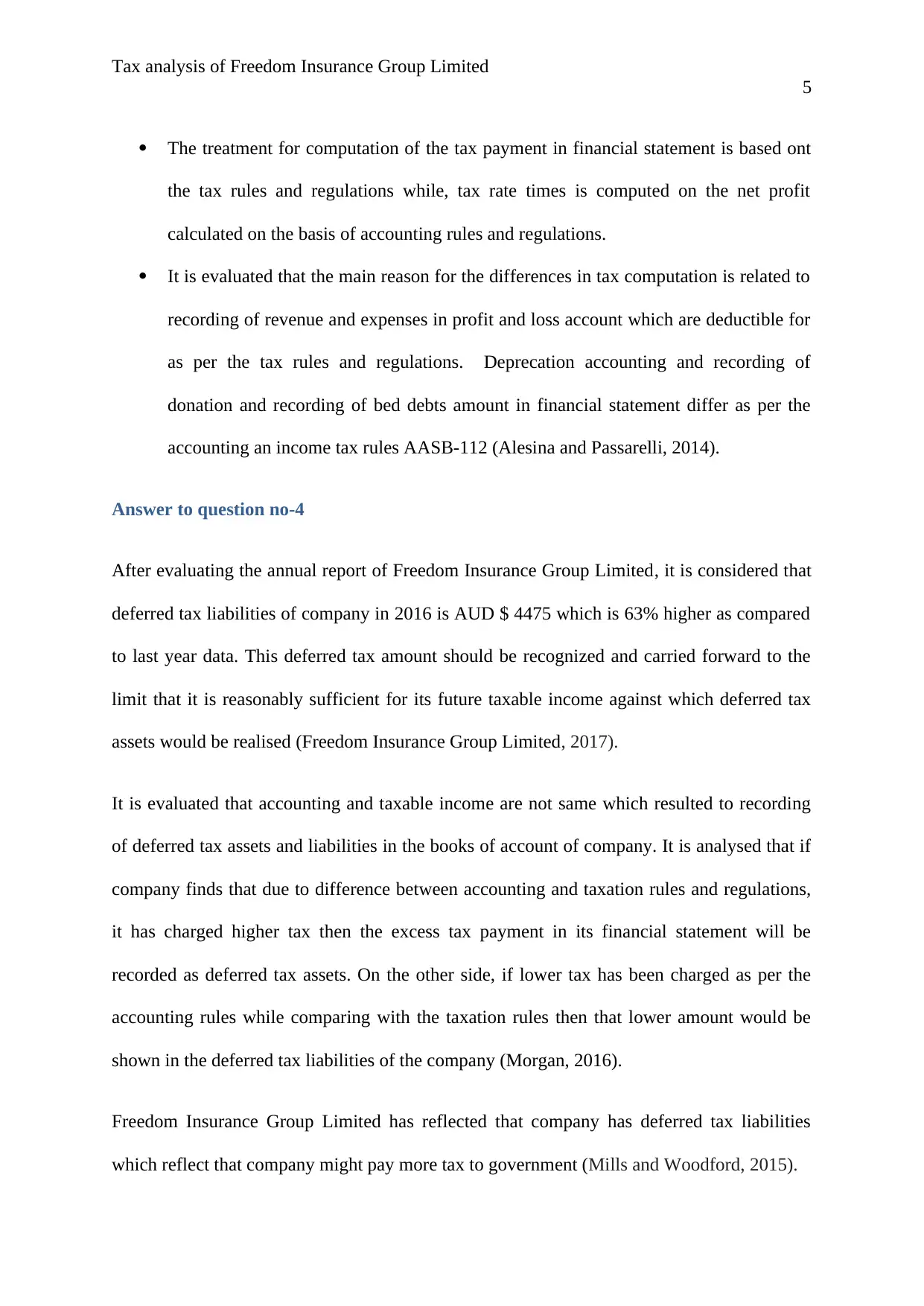
Tax analysis of Freedom Insurance Group Limited
5
The treatment for computation of the tax payment in financial statement is based ont
the tax rules and regulations while, tax rate times is computed on the net profit
calculated on the basis of accounting rules and regulations.
It is evaluated that the main reason for the differences in tax computation is related to
recording of revenue and expenses in profit and loss account which are deductible for
as per the tax rules and regulations. Deprecation accounting and recording of
donation and recording of bed debts amount in financial statement differ as per the
accounting an income tax rules AASB-112 (Alesina and Passarelli, 2014).
Answer to question no-4
After evaluating the annual report of Freedom Insurance Group Limited, it is considered that
deferred tax liabilities of company in 2016 is AUD $ 4475 which is 63% higher as compared
to last year data. This deferred tax amount should be recognized and carried forward to the
limit that it is reasonably sufficient for its future taxable income against which deferred tax
assets would be realised (Freedom Insurance Group Limited, 2017).
It is evaluated that accounting and taxable income are not same which resulted to recording
of deferred tax assets and liabilities in the books of account of company. It is analysed that if
company finds that due to difference between accounting and taxation rules and regulations,
it has charged higher tax then the excess tax payment in its financial statement will be
recorded as deferred tax assets. On the other side, if lower tax has been charged as per the
accounting rules while comparing with the taxation rules then that lower amount would be
shown in the deferred tax liabilities of the company (Morgan, 2016).
Freedom Insurance Group Limited has reflected that company has deferred tax liabilities
which reflect that company might pay more tax to government (Mills and Woodford, 2015).
5
The treatment for computation of the tax payment in financial statement is based ont
the tax rules and regulations while, tax rate times is computed on the net profit
calculated on the basis of accounting rules and regulations.
It is evaluated that the main reason for the differences in tax computation is related to
recording of revenue and expenses in profit and loss account which are deductible for
as per the tax rules and regulations. Deprecation accounting and recording of
donation and recording of bed debts amount in financial statement differ as per the
accounting an income tax rules AASB-112 (Alesina and Passarelli, 2014).
Answer to question no-4
After evaluating the annual report of Freedom Insurance Group Limited, it is considered that
deferred tax liabilities of company in 2016 is AUD $ 4475 which is 63% higher as compared
to last year data. This deferred tax amount should be recognized and carried forward to the
limit that it is reasonably sufficient for its future taxable income against which deferred tax
assets would be realised (Freedom Insurance Group Limited, 2017).
It is evaluated that accounting and taxable income are not same which resulted to recording
of deferred tax assets and liabilities in the books of account of company. It is analysed that if
company finds that due to difference between accounting and taxation rules and regulations,
it has charged higher tax then the excess tax payment in its financial statement will be
recorded as deferred tax assets. On the other side, if lower tax has been charged as per the
accounting rules while comparing with the taxation rules then that lower amount would be
shown in the deferred tax liabilities of the company (Morgan, 2016).
Freedom Insurance Group Limited has reflected that company has deferred tax liabilities
which reflect that company might pay more tax to government (Mills and Woodford, 2015).
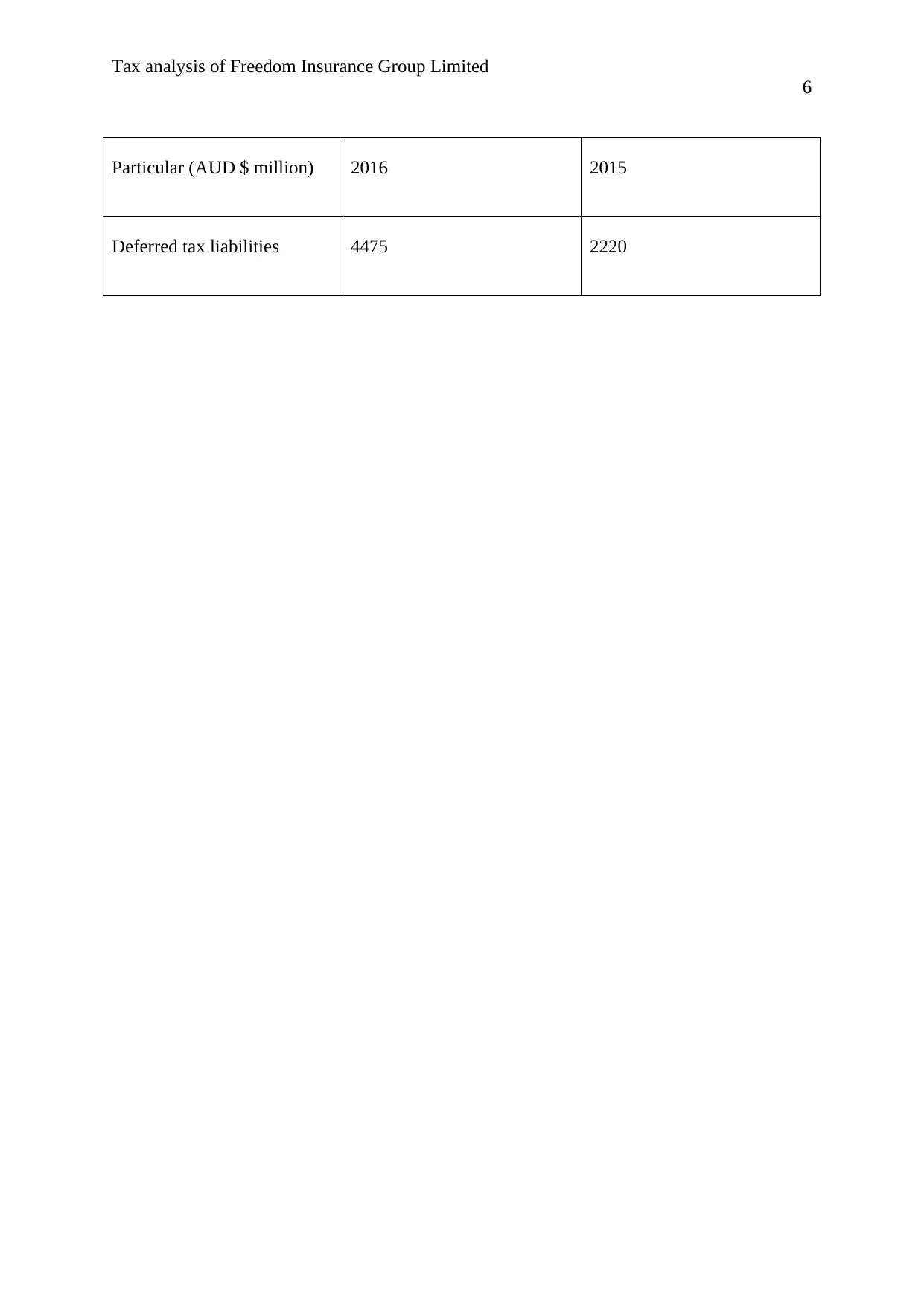
Tax analysis of Freedom Insurance Group Limited
6
Particular (AUD $ million) 2016 2015
Deferred tax liabilities 4475 2220
6
Particular (AUD $ million) 2016 2015
Deferred tax liabilities 4475 2220
⊘ This is a preview!⊘
Do you want full access?
Subscribe today to unlock all pages.

Trusted by 1+ million students worldwide
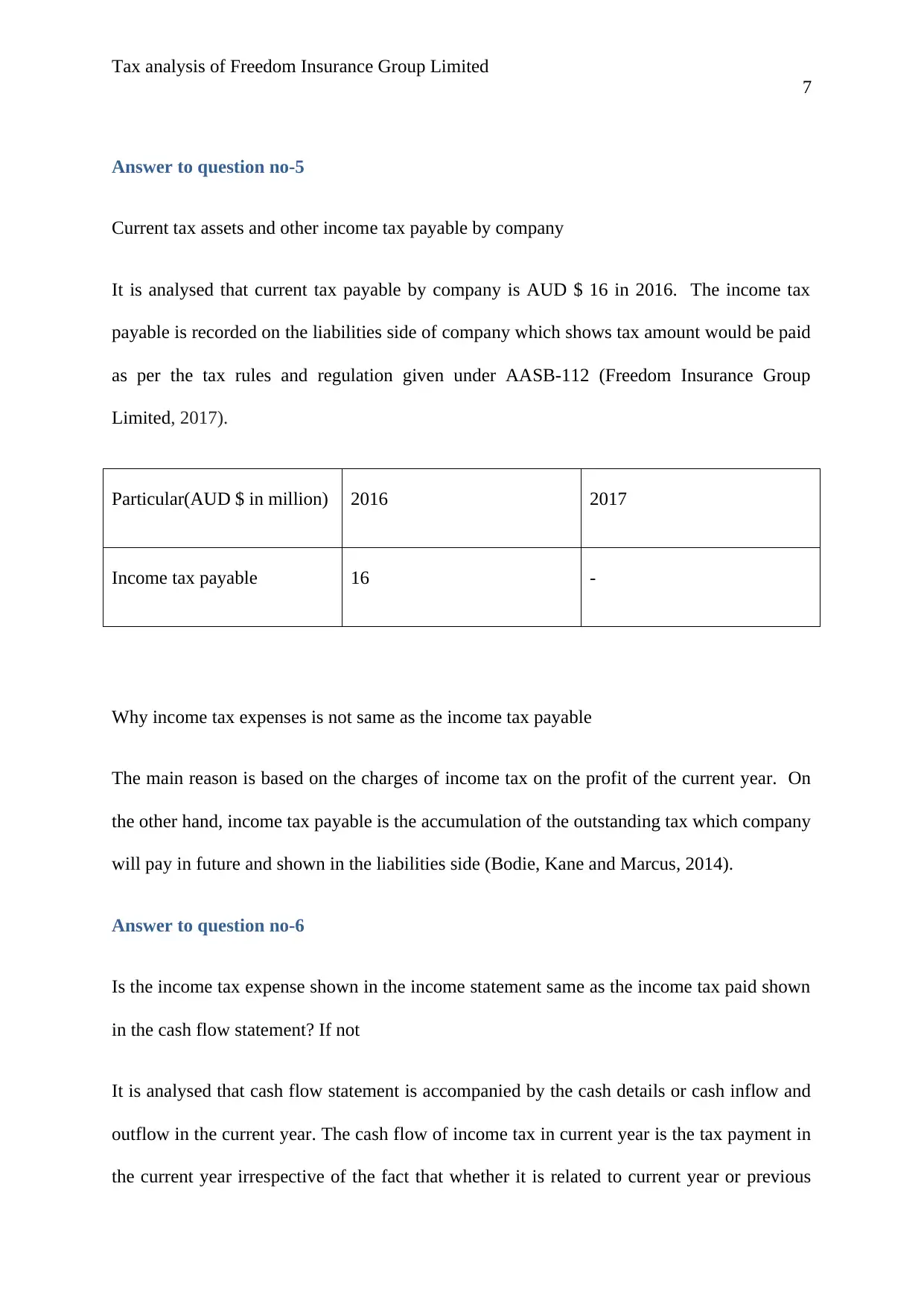
Tax analysis of Freedom Insurance Group Limited
7
Answer to question no-5
Current tax assets and other income tax payable by company
It is analysed that current tax payable by company is AUD $ 16 in 2016. The income tax
payable is recorded on the liabilities side of company which shows tax amount would be paid
as per the tax rules and regulation given under AASB-112 (Freedom Insurance Group
Limited, 2017).
Particular(AUD $ in million) 2016 2017
Income tax payable 16 -
Why income tax expenses is not same as the income tax payable
The main reason is based on the charges of income tax on the profit of the current year. On
the other hand, income tax payable is the accumulation of the outstanding tax which company
will pay in future and shown in the liabilities side (Bodie, Kane and Marcus, 2014).
Answer to question no-6
Is the income tax expense shown in the income statement same as the income tax paid shown
in the cash flow statement? If not
It is analysed that cash flow statement is accompanied by the cash details or cash inflow and
outflow in the current year. The cash flow of income tax in current year is the tax payment in
the current year irrespective of the fact that whether it is related to current year or previous
7
Answer to question no-5
Current tax assets and other income tax payable by company
It is analysed that current tax payable by company is AUD $ 16 in 2016. The income tax
payable is recorded on the liabilities side of company which shows tax amount would be paid
as per the tax rules and regulation given under AASB-112 (Freedom Insurance Group
Limited, 2017).
Particular(AUD $ in million) 2016 2017
Income tax payable 16 -
Why income tax expenses is not same as the income tax payable
The main reason is based on the charges of income tax on the profit of the current year. On
the other hand, income tax payable is the accumulation of the outstanding tax which company
will pay in future and shown in the liabilities side (Bodie, Kane and Marcus, 2014).
Answer to question no-6
Is the income tax expense shown in the income statement same as the income tax paid shown
in the cash flow statement? If not
It is analysed that cash flow statement is accompanied by the cash details or cash inflow and
outflow in the current year. The cash flow of income tax in current year is the tax payment in
the current year irrespective of the fact that whether it is related to current year or previous
Paraphrase This Document
Need a fresh take? Get an instant paraphrase of this document with our AI Paraphraser
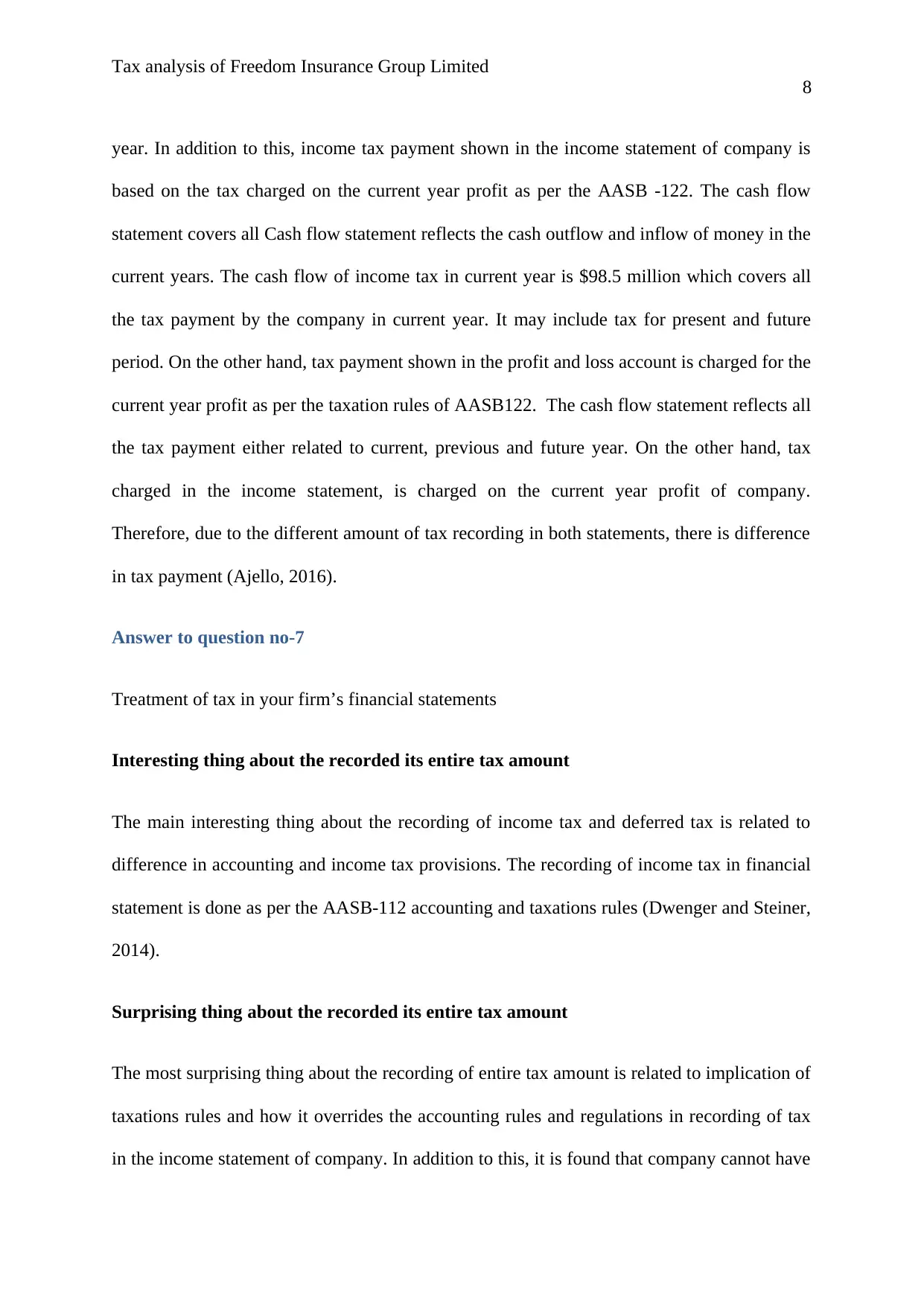
Tax analysis of Freedom Insurance Group Limited
8
year. In addition to this, income tax payment shown in the income statement of company is
based on the tax charged on the current year profit as per the AASB -122. The cash flow
statement covers all Cash flow statement reflects the cash outflow and inflow of money in the
current years. The cash flow of income tax in current year is $98.5 million which covers all
the tax payment by the company in current year. It may include tax for present and future
period. On the other hand, tax payment shown in the profit and loss account is charged for the
current year profit as per the taxation rules of AASB122. The cash flow statement reflects all
the tax payment either related to current, previous and future year. On the other hand, tax
charged in the income statement, is charged on the current year profit of company.
Therefore, due to the different amount of tax recording in both statements, there is difference
in tax payment (Ajello, 2016).
Answer to question no-7
Treatment of tax in your firm’s financial statements
Interesting thing about the recorded its entire tax amount
The main interesting thing about the recording of income tax and deferred tax is related to
difference in accounting and income tax provisions. The recording of income tax in financial
statement is done as per the AASB-112 accounting and taxations rules (Dwenger and Steiner,
2014).
Surprising thing about the recorded its entire tax amount
The most surprising thing about the recording of entire tax amount is related to implication of
taxations rules and how it overrides the accounting rules and regulations in recording of tax
in the income statement of company. In addition to this, it is found that company cannot have
8
year. In addition to this, income tax payment shown in the income statement of company is
based on the tax charged on the current year profit as per the AASB -122. The cash flow
statement covers all Cash flow statement reflects the cash outflow and inflow of money in the
current years. The cash flow of income tax in current year is $98.5 million which covers all
the tax payment by the company in current year. It may include tax for present and future
period. On the other hand, tax payment shown in the profit and loss account is charged for the
current year profit as per the taxation rules of AASB122. The cash flow statement reflects all
the tax payment either related to current, previous and future year. On the other hand, tax
charged in the income statement, is charged on the current year profit of company.
Therefore, due to the different amount of tax recording in both statements, there is difference
in tax payment (Ajello, 2016).
Answer to question no-7
Treatment of tax in your firm’s financial statements
Interesting thing about the recorded its entire tax amount
The main interesting thing about the recording of income tax and deferred tax is related to
difference in accounting and income tax provisions. The recording of income tax in financial
statement is done as per the AASB-112 accounting and taxations rules (Dwenger and Steiner,
2014).
Surprising thing about the recorded its entire tax amount
The most surprising thing about the recording of entire tax amount is related to implication of
taxations rules and how it overrides the accounting rules and regulations in recording of tax
in the income statement of company. In addition to this, it is found that company cannot have
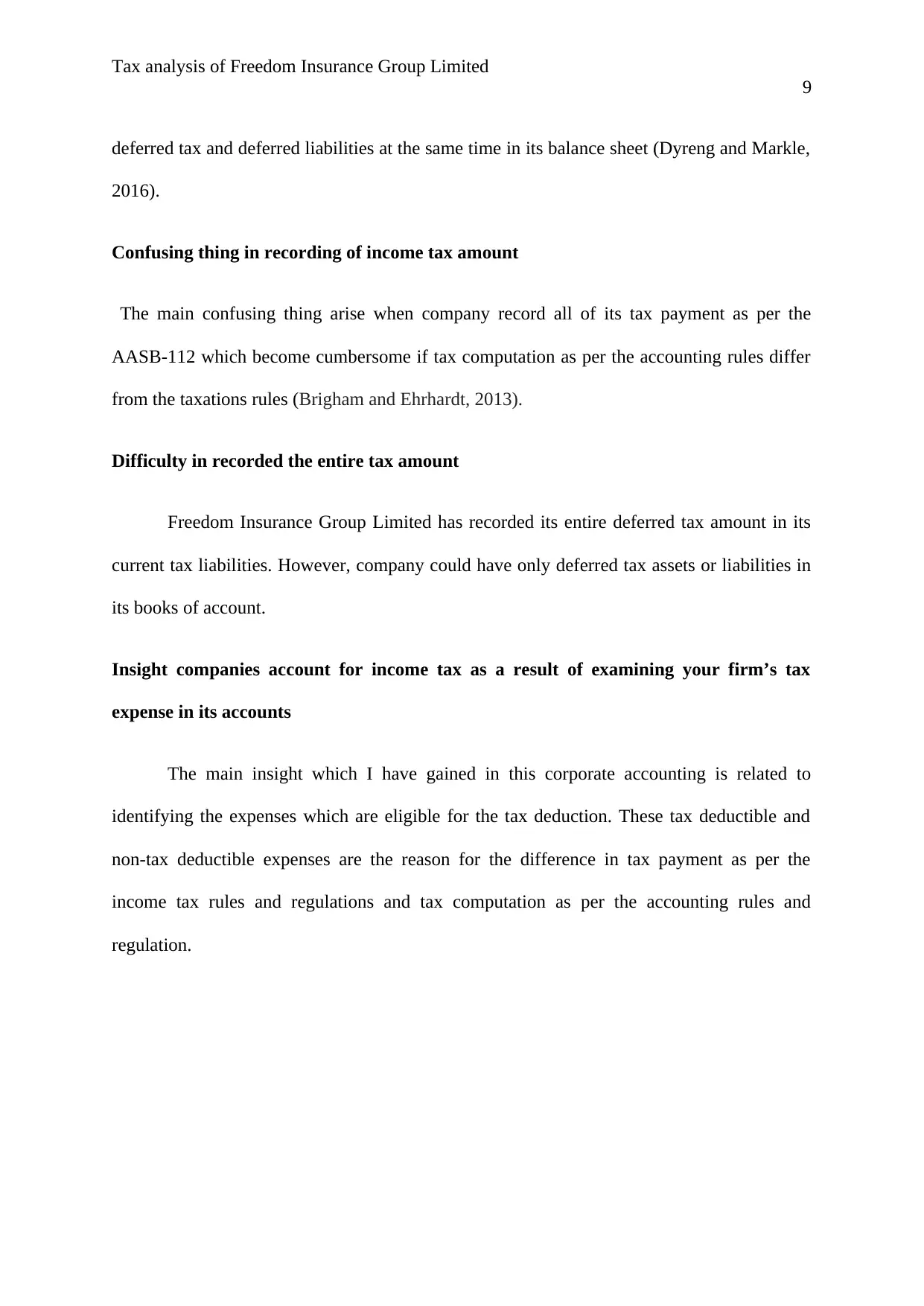
Tax analysis of Freedom Insurance Group Limited
9
deferred tax and deferred liabilities at the same time in its balance sheet (Dyreng and Markle,
2016).
Confusing thing in recording of income tax amount
The main confusing thing arise when company record all of its tax payment as per the
AASB-112 which become cumbersome if tax computation as per the accounting rules differ
from the taxations rules (Brigham and Ehrhardt, 2013).
Difficulty in recorded the entire tax amount
Freedom Insurance Group Limited has recorded its entire deferred tax amount in its
current tax liabilities. However, company could have only deferred tax assets or liabilities in
its books of account.
Insight companies account for income tax as a result of examining your firm’s tax
expense in its accounts
The main insight which I have gained in this corporate accounting is related to
identifying the expenses which are eligible for the tax deduction. These tax deductible and
non-tax deductible expenses are the reason for the difference in tax payment as per the
income tax rules and regulations and tax computation as per the accounting rules and
regulation.
9
deferred tax and deferred liabilities at the same time in its balance sheet (Dyreng and Markle,
2016).
Confusing thing in recording of income tax amount
The main confusing thing arise when company record all of its tax payment as per the
AASB-112 which become cumbersome if tax computation as per the accounting rules differ
from the taxations rules (Brigham and Ehrhardt, 2013).
Difficulty in recorded the entire tax amount
Freedom Insurance Group Limited has recorded its entire deferred tax amount in its
current tax liabilities. However, company could have only deferred tax assets or liabilities in
its books of account.
Insight companies account for income tax as a result of examining your firm’s tax
expense in its accounts
The main insight which I have gained in this corporate accounting is related to
identifying the expenses which are eligible for the tax deduction. These tax deductible and
non-tax deductible expenses are the reason for the difference in tax payment as per the
income tax rules and regulations and tax computation as per the accounting rules and
regulation.
⊘ This is a preview!⊘
Do you want full access?
Subscribe today to unlock all pages.

Trusted by 1+ million students worldwide
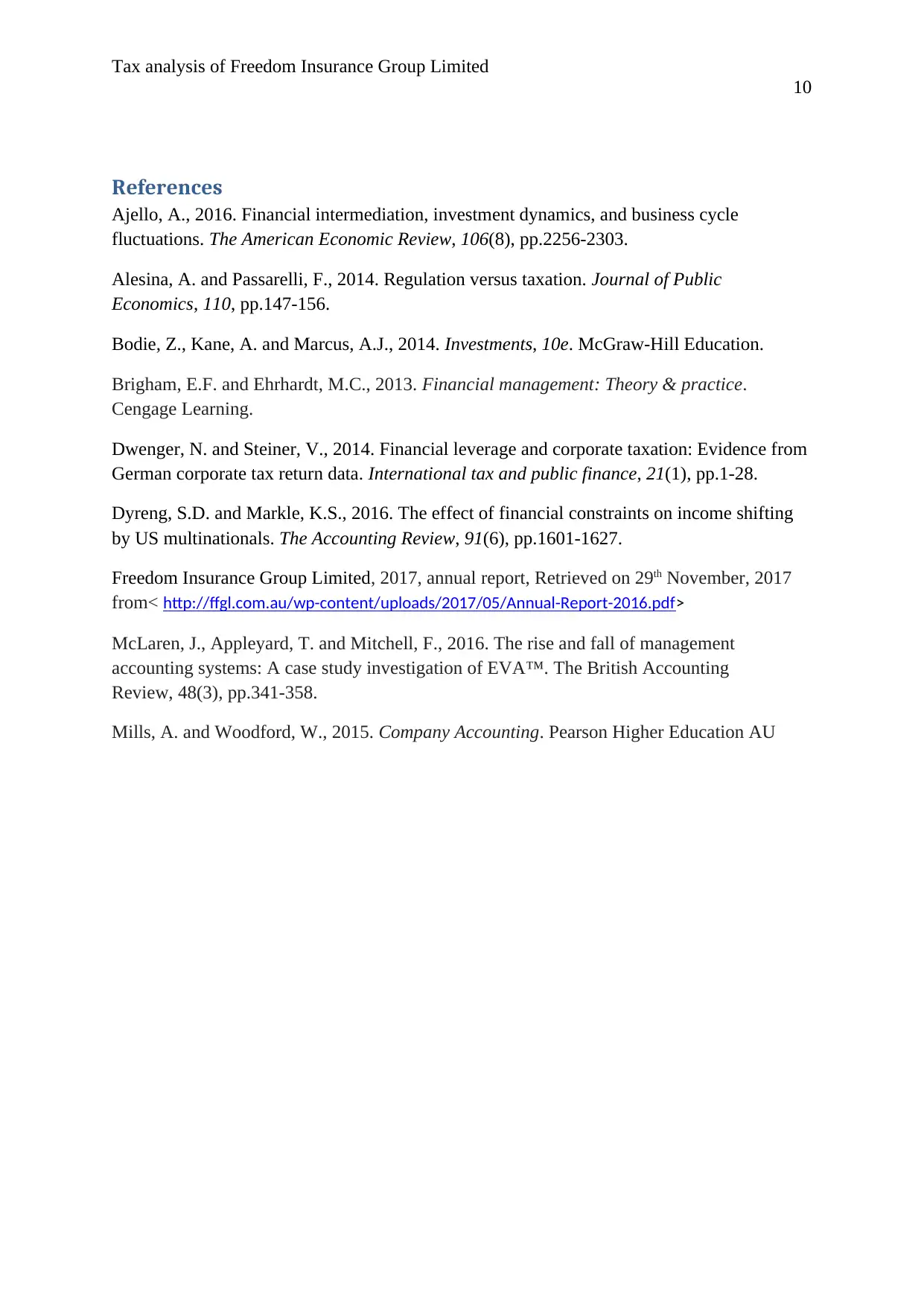
Tax analysis of Freedom Insurance Group Limited
10
References
Ajello, A., 2016. Financial intermediation, investment dynamics, and business cycle
fluctuations. The American Economic Review, 106(8), pp.2256-2303.
Alesina, A. and Passarelli, F., 2014. Regulation versus taxation. Journal of Public
Economics, 110, pp.147-156.
Bodie, Z., Kane, A. and Marcus, A.J., 2014. Investments, 10e. McGraw-Hill Education.
Brigham, E.F. and Ehrhardt, M.C., 2013. Financial management: Theory & practice.
Cengage Learning.
Dwenger, N. and Steiner, V., 2014. Financial leverage and corporate taxation: Evidence from
German corporate tax return data. International tax and public finance, 21(1), pp.1-28.
Dyreng, S.D. and Markle, K.S., 2016. The effect of financial constraints on income shifting
by US multinationals. The Accounting Review, 91(6), pp.1601-1627.
Freedom Insurance Group Limited, 2017, annual report, Retrieved on 29th November, 2017
from< http://ffgl.com.au/wp-content/uploads/2017/05/Annual-Report-2016.pdf>
McLaren, J., Appleyard, T. and Mitchell, F., 2016. The rise and fall of management
accounting systems: A case study investigation of EVA™. The British Accounting
Review, 48(3), pp.341-358.
Mills, A. and Woodford, W., 2015. Company Accounting. Pearson Higher Education AU
10
References
Ajello, A., 2016. Financial intermediation, investment dynamics, and business cycle
fluctuations. The American Economic Review, 106(8), pp.2256-2303.
Alesina, A. and Passarelli, F., 2014. Regulation versus taxation. Journal of Public
Economics, 110, pp.147-156.
Bodie, Z., Kane, A. and Marcus, A.J., 2014. Investments, 10e. McGraw-Hill Education.
Brigham, E.F. and Ehrhardt, M.C., 2013. Financial management: Theory & practice.
Cengage Learning.
Dwenger, N. and Steiner, V., 2014. Financial leverage and corporate taxation: Evidence from
German corporate tax return data. International tax and public finance, 21(1), pp.1-28.
Dyreng, S.D. and Markle, K.S., 2016. The effect of financial constraints on income shifting
by US multinationals. The Accounting Review, 91(6), pp.1601-1627.
Freedom Insurance Group Limited, 2017, annual report, Retrieved on 29th November, 2017
from< http://ffgl.com.au/wp-content/uploads/2017/05/Annual-Report-2016.pdf>
McLaren, J., Appleyard, T. and Mitchell, F., 2016. The rise and fall of management
accounting systems: A case study investigation of EVA™. The British Accounting
Review, 48(3), pp.341-358.
Mills, A. and Woodford, W., 2015. Company Accounting. Pearson Higher Education AU
Paraphrase This Document
Need a fresh take? Get an instant paraphrase of this document with our AI Paraphraser
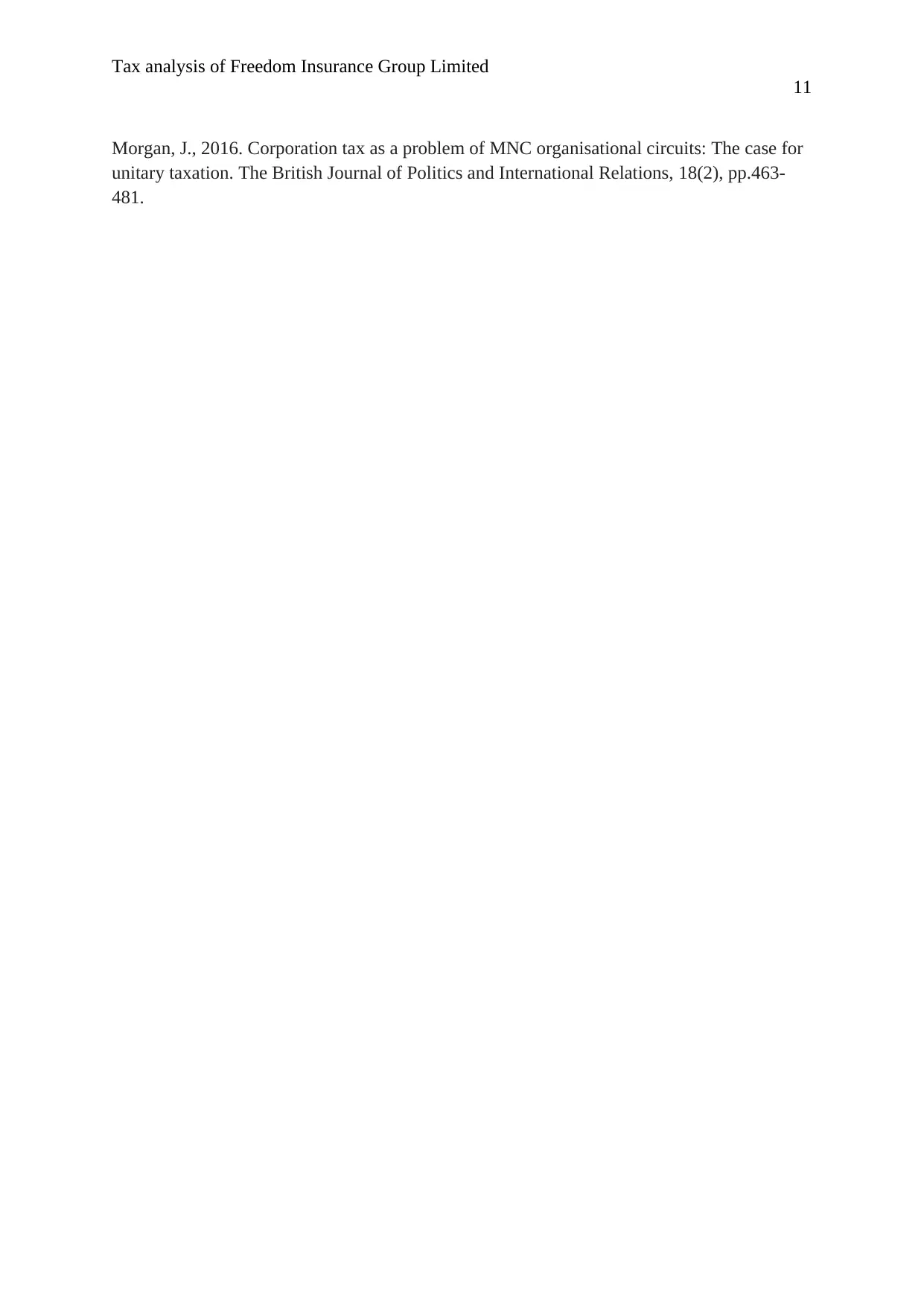
Tax analysis of Freedom Insurance Group Limited
11
Morgan, J., 2016. Corporation tax as a problem of MNC organisational circuits: The case for
unitary taxation. The British Journal of Politics and International Relations, 18(2), pp.463-
481.
11
Morgan, J., 2016. Corporation tax as a problem of MNC organisational circuits: The case for
unitary taxation. The British Journal of Politics and International Relations, 18(2), pp.463-
481.
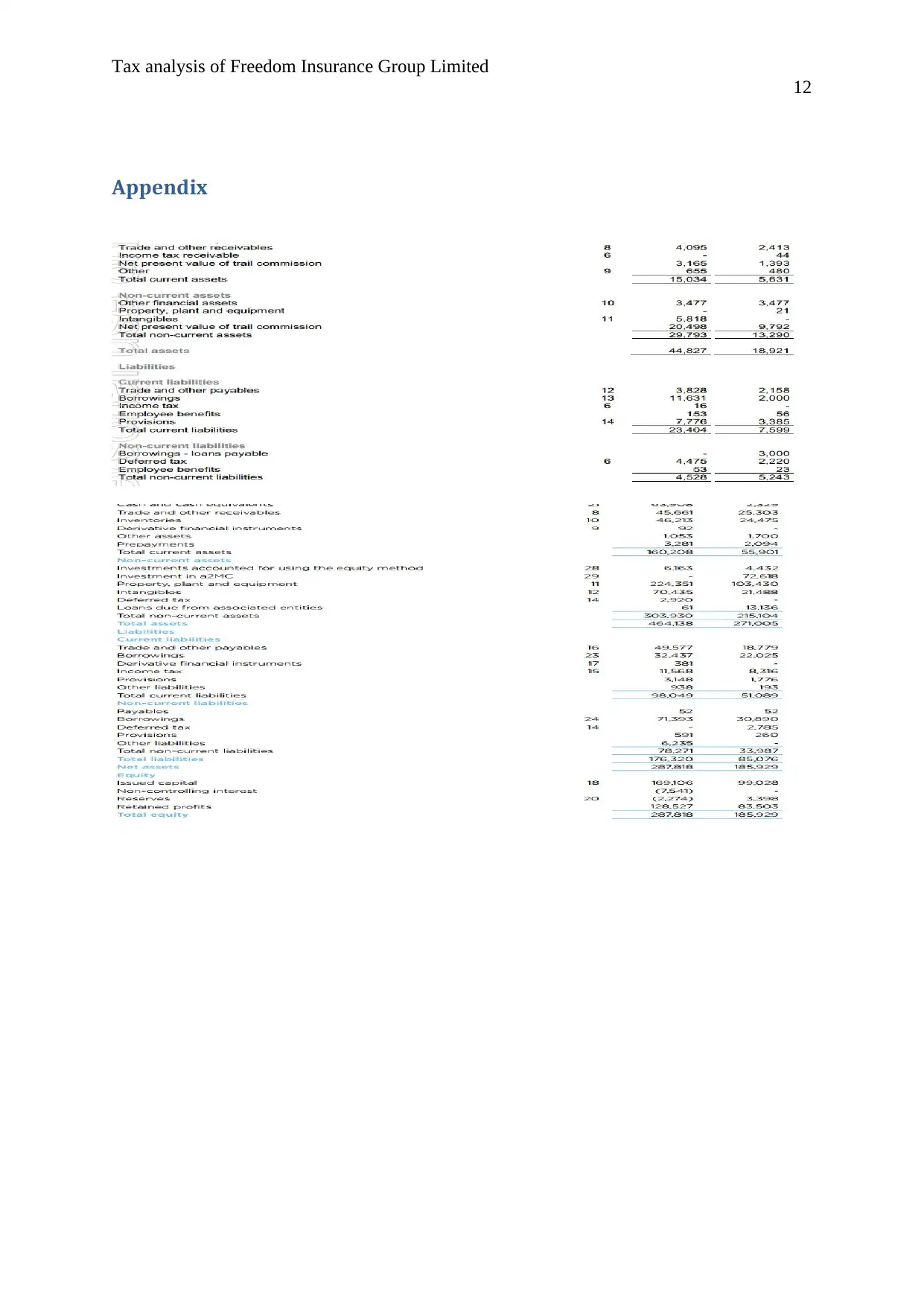
Tax analysis of Freedom Insurance Group Limited
12
Appendix
12
Appendix
⊘ This is a preview!⊘
Do you want full access?
Subscribe today to unlock all pages.

Trusted by 1+ million students worldwide
1 out of 12
Related Documents
Your All-in-One AI-Powered Toolkit for Academic Success.
+13062052269
info@desklib.com
Available 24*7 on WhatsApp / Email
![[object Object]](/_next/static/media/star-bottom.7253800d.svg)
Unlock your academic potential
Copyright © 2020–2025 A2Z Services. All Rights Reserved. Developed and managed by ZUCOL.





